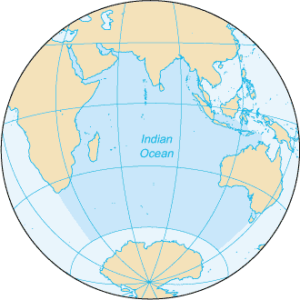In news : Raksha Mantri’s keynote address at IOR Defence Ministers’ Conclave stresses on Prime Minister’s ‘Five S’ vision to tackle global challenges
The Five S are
The Defence Minister said India’s approach and vision to tackle global challenges was highlighted by Prime Minister Shri Narendra Modi’s dynamic five ‘S’ vision –
- Samman (Respect)
- Samvaad (Dialogue)
- Sahyog (Cooperation)
- Shanti (Peace) and
- Samriddhi (Prosperity).
About the Indian Ocean Region(IOR)
- The Indian Ocean is the world’s third-largest ocean and constitutes about 20 percent of the water on the Earth’s surface.
- The Indian Ocean region is one of growing geopolitical importance and is characterized by competition and intense rivalries involving both littoral states and external powers.
- The IOR broadly defines areas consisting of littoral states of the Indian Ocean
- Marked by a glaring cultural, social, political and economic diversity, IOR comprises a number of sub-regions, such as Australia, South East Asia, South Asia, Horn of Africa and the Southern and Eastern Africa.
- The IOR littorals house more than one-third of world’s population.
- Sea borne trade: In addition, more than half of the global seaborne trade and commerce passes through the Indian Ocean out of which, almost 70 per cent goes to countries external to the region.
- Resources: The IOR littoral states are rich in producing various raw materials, primarily oil, which are key to development of major manufacturing industries of developed as well as developing nations.
- Complementary to this is the enormous seabed resources possessed by IOR comprising oil and natural gas reserves, minerals and abundance of fishes.
- Location: It is bounded on the west by East Africa, on the north by India, on the east by Indochina and Australia, and on the south by the Southern Ocean off the coast of Antarctica
- Role in economy: Indian Ocean is a shared asset and a lifeline to international trade and transport due to its control of major sea-lanes carrying half of the world’s container ships, one third of the world’s bulk cargo traffic and two thirds of the world’s oil shipments.
- Countries bordering Indian Ocean: The Indian Ocean is bounded by Iran, Pakistan, India, and Bangladesh to the north; the Malay Peninsula, the Sunda Islands of Indonesia, and Australia to the east; Antarctica to the south; and Africa and the Arabian Peninsula to the west.
- In the southwest it joins the Atlantic Ocean south of the southern tip of Africa, and to the east and southeast its waters mingle with those of the Pacific Ocean.

Geo-Strategic Importance of IOR to India
- India’s central position in the IOR gives her an immense advantage and at the same time presents far greater challenges.
- Looking through the prism of optimism, however, a pragmatic maritime approach could well convert these challenges into opportunities which would help India achieve her quest for becoming a global power.
- India has a coastline of over 7500 km, a total of over 1200 Islands and about two million square km of EEZ.
- Nearly 80 per cent of India’s crude oil requirement is imported, which are mostly routed through the sea
- Taking into account the total oil imports by sea, offshore oil production and petroleum exports, the country’s cumulative ‘sea dependence’ for oil is estimated to be about 93 per cent.
- Almost 95 per cent of India’s trade by volume and 68 per cent of trade by value are routed via the Indian Ocean.
- Any impediment to flow of commercial traffic would have disastrous ramifications on her economic objectives.
- India depends heavily on Indian Ocean resources with her fishing and aquaculture industries being a major source of export as well as providing employment to more than 14 million people.
- Militarily, the presence of such a long coastline makes India vulnerable to potential threats emerging from the sea.
- One of the worst terrorist attacks on India in recent memory – the 2008 Mumbai attack – was perpetrated by terrorists arriving by sea.
- The presence of non-traditional threats like piracy, smuggling, illegal fishing and human trafficking also present major challenges and hence, a secure Indian Ocean is key to securing India’s national interests.
- SAGAR – Security and Growth for All in the Region is the theme of Indian Ocean Policy as outlined by Prime Minister Shri Narendra Modi in 2015.














